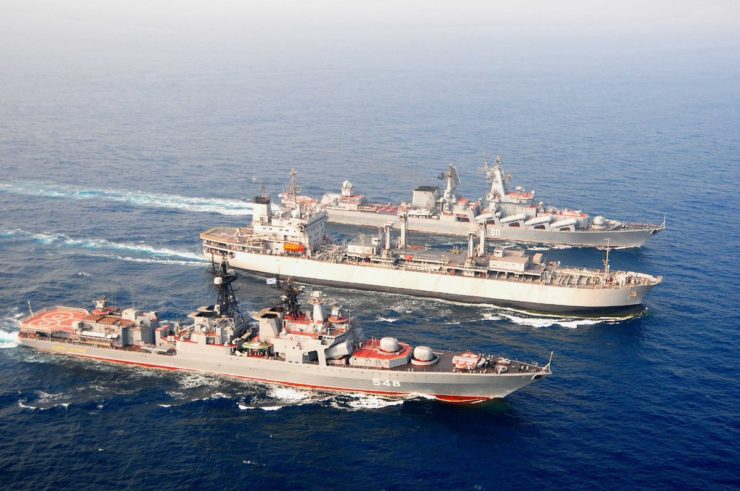
Changing geopolitical realities and the deteriorating image of the United States are resulting in novel alliances around the world. The unipolar world under the hegemony of the United States has sparked a sense of injustice and maltreatment due to its dictatorial attitude. Military and diplomatic interventions by the United States have widened the gulf between the global north and the global south. In the recent geopolitical shifts, Russia and China have emerged as the new superpowers of the world. The global south looks at them as the new viable option for an alliance. The expansion of BRICS has further enhanced the significance of these two superpowers. Moreover, Russia is also looking to play a larger role in global affairs. In pursuit of this goal, Russia is boosting its presence in the Indian Ocean and bolstering its ties with the developing countries of Asia.
The country increased its naval activities in November. Russia and Myanmar conducted their biggest naval exercises from the 7th to the 9th of November in the Andaman Sea. Russia’s Ministry of Defense held that this was the first collaborative military exercise in modern history. Admiral Tributs, Admiral Panteleyev, and two anti-submarine ships of the Pacific Fleet of Russia along with a corvette and a frigate of Myanmar’s navy participated in these exercises. The Western sanctions on Myanmar and Russia have brought the two countries closer. This escalating partnership is mutually beneficial for Russia and Myanmar, as the latter can satisfy its arms needs and the former can excess a new market for its arms and weapons.
Russia is also increasing its naval ties with other regional countries. These countries are also welcoming the Russian naval presence in the Indian Ocean with much enthusiasm. The same Russian fleet paid their first-ever visit to Chittagong Port of Bangladesh in the last 50 years. This was labeled as a huge milestone for the relationship between the two countries. Bangladesh and Russia enjoy close historical ties. The US pressure on Bangladesh due to its increasing cordiality with China and its independent regional decisions has further cemented the cordiality between Russia and Bangladesh. The latter is also building its first nuclear power plant, the Rooppur Power Plant, with the collaboration of Russia.
India, one of the key players in the region, is also a traditional ally of Russia. Both countries have been conducting biennial naval exercises since 2008. The two countries also conducted a naval drill in the Bay of Bengal to strengthen their naval cooperation after the Russia-Bangladesh naval drills. The naval exercises between the two regional powers also hold great significance. Along with enhancing their naval cooperation, these exercises are seen as a crucial development to counter the increasing threats in the Indian Ocean and for ensuring the safety of civilian ships in the region by many analysts. India is also welcoming Russian presence in the Indian Ocean. Russian presence in the Indian Ocean also strengthens the Indian dream of a multipolar world order. Michael Kugelman, Director of the South Asia Institute at the Wilson Center in Washington, India views Russian presence in the region as an opportunity to counterbalance the presence of its traditional enemy, China.
The timing of these military drills with the different countries of the region holds extreme significant. Russia is conducting these exercises at a time when the whole world is at a decisive juncture. The Indian Ocean is a key region for the great power rivalry between China and the United States. Russia’s presence in the region holds a great eminence. Russia seeks to achieve its multiple goals through this presence. It will help the country to counter the rising US presence in the region. Russia’s increasing ties with the global south, especially the developing nations in South Asia, come as a message to the United States and its allies that the West cannot isolate it through its unilateral decisions.
In March 2023, Russia also conducted naval drills with China and Iran in the Eastern part of the Indian Ocean. Russia seeks to project its power far from home through these exercises. In addition, these exercises are important for Russia to explore the regional arms markets, as arms trade is its major economic tool after energy trade. Furthermore, these military exercises will help in the recognition of Russia as a military partner of some of the key regional players. This will deteriorate the Western attempts to malign Russia globally. Military and naval exercises with different regional countries of South Asia, one of the rapidly growing regions for imports of arms – will also augment the demand for Russia weapons in these countries. The country will also have a greater influence on the trade and economic hub – the Indian Ocean, through enhancing ties with the South Asian countries. On the other hand, the South Asian nations also have much to gain from the Russian partnership. Most of the regional countries seek infrastructural development. Russia can help in the infrastructural and technological development of these countries. The expansion of BRICS has increased the significance of Russia globally. The smaller nations of South Asia can gain BRICS membership with the help of Russia. Moreover, they will have a much more viable alternate for their long-term collaboration and cooperation in the face of Russia, instead of the United States, which is rapidly losing its soft image.
Abbas Hashemite – is a political observer and research analyst for regional and global geopolitical issues. He is currently working as an independent researcher and journalist, exclusively for “New Eastern Outlook”.
